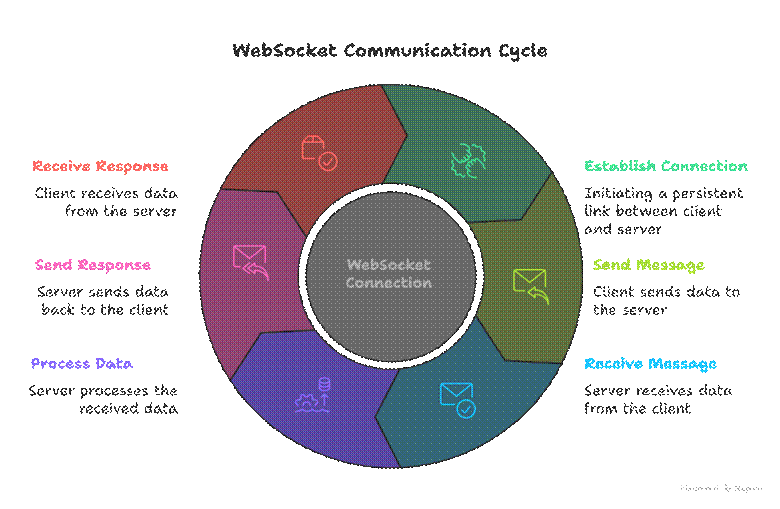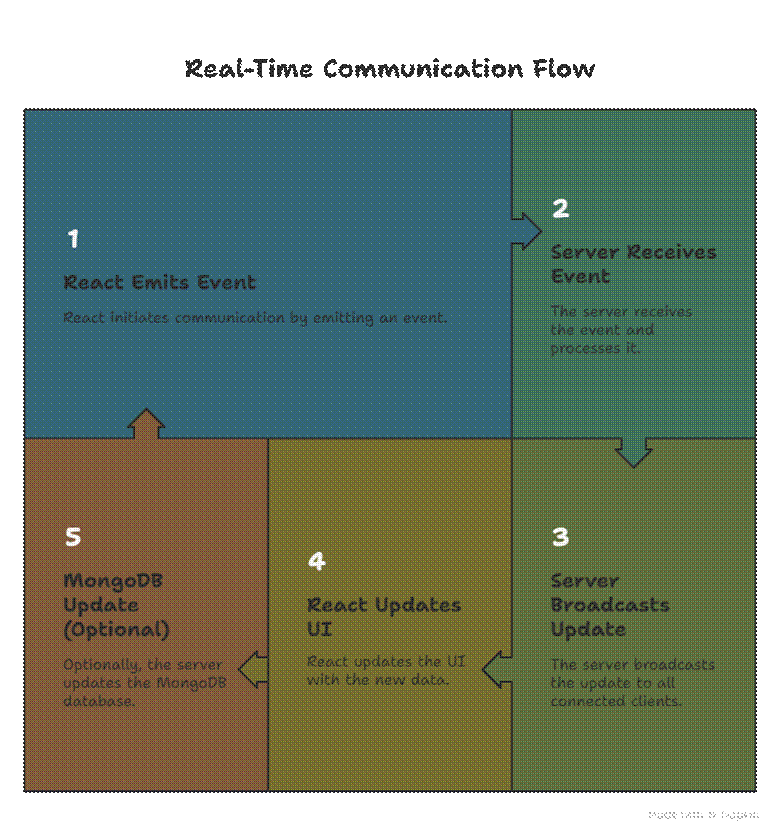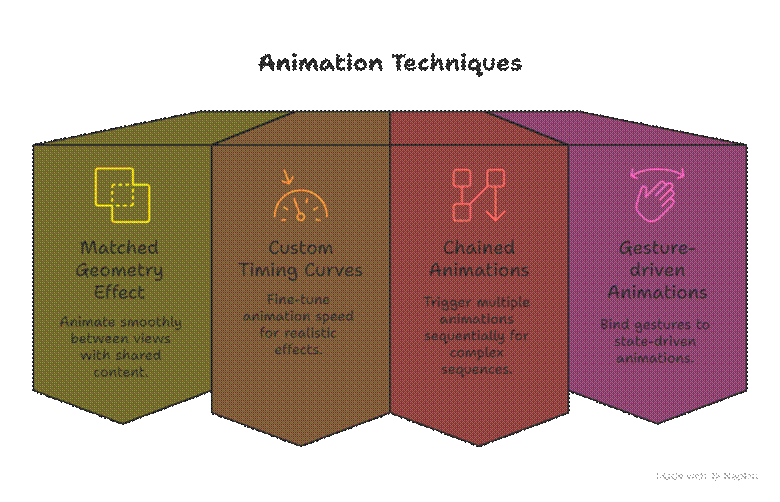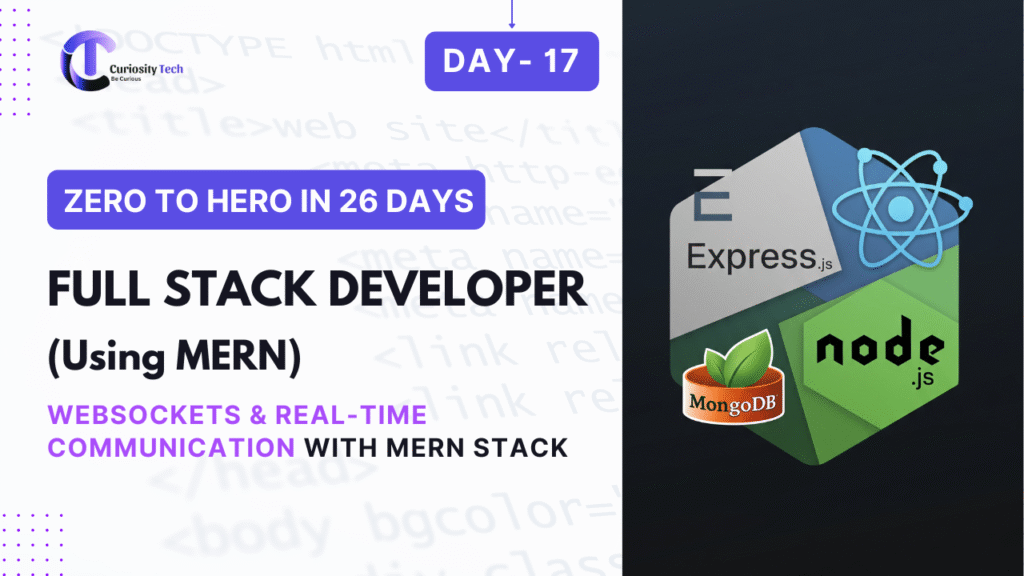Introduction
Modern web applications increasingly demand real-time interactivity, such as live chat, notifications, dashboards, or collaborative tools. In MERN Stack development, WebSockets enable bi-directional communication between the client (React) and server (Node.js + Express), going beyond traditional HTTP request-response patterns.
CuriosityTech.in emphasizes real-world applications of WebSockets, allowing learners to implement live features in MERN projects and understand the architecture of real-time systems.
Understanding WebSockets
Unlike HTTP, which is request-response based, WebSockets establish a persistent connection:
- Both client and server can send and receive messages anytime.
- Reduces overhead compared to repeated HTTP requests (polling).
- Ideal for chat apps, notifications, live dashboards, multiplayer apps.
Diagram – WebSocket Flow:

Step 1: Setting Up WebSockets with Socket.IO
Socket.IO simplifies real-time communication in MERN applications.
npm install socket.io
npm install socket.io-client
Step 2: Backend – Node.js + Express + Socket.IO
const express = require(‘express’);
const http = require(‘http’);
const { Server } = require(‘socket.io’);
const app = express();
const server = http.createServer(app);
const io = new Server(server, { cors: { origin: ‘*’ } });
io.on(‘connection’, (socket) => {
console.log(‘User connected:’, socket.id);
socket.on(‘sendMessage’, (msg) => {
io.emit(‘receiveMessage’, msg); // broadcast message to all clients
});
socket.on(‘disconnect’, () => {
console.log(‘User disconnected:’, socket.id);
});
});
server.listen(5000, () => console.log(‘Server running on port 5000’));
Step 3: Frontend – React + Socket.IO Client
import { useEffect, useState } from ‘react’;
import { io } from ‘socket.io-client’;
const socket = io(‘http://localhost:5000’);
function ChatApp() {
const [message, setMessage] = useState(”);
const [chat, setChat] = useState([]);
useEffect(() => {
socket.on(‘receiveMessage’, (msg) => setChat((prev) => […prev, msg]));
}, []);
const sendMessage = () => {
socket.emit(‘sendMessage’, message);
setMessage(”);
};
return (
<div>
<h1>Live Chat</h1>
<input value={message} onChange={(e) => setMessage(e.target.value)} placeholder=”Type a message” />
<button onClick={sendMessage}>Send</button>
<div>
{chat.map((msg, index) => <p key={index}>{msg}</p>)}
</div>
</div>
);
}
export default ChatApp;
Step 4: Combining WebSockets with MongoDB
For persistent chat history:
- Store messages in MongoDB via Mongoose.
- Emit messages to clients using Socket.IO.
Example Table – Real-Time Chat Flow:
| Event | Action | Backend | Frontend |
| User sends message | Emit sendMessage event | Listen, save to MongoDB | Update chat array via receiveMessage |
| Server broadcasts | Send message to all connected clients | io.emit(‘receiveMessage’) | Append message to UI |
| User disconnects | Notify others or handle cleanup | socket.on(‘disconnect’) | Optional UI notification |
Step 5: Best Practices for Real-Time MERN Apps
- Manage Connections Efficiently: Limit connections and handle disconnects gracefully.
- Use Namespaces and Rooms: For private chats or group channels.
- Validate Messages: Prevent XSS and spam.
- Combine with Authentication: Verify users via JWT before establishing WebSocket connection.
- Optimize Performance: Use message batching, compression, and limit broadcast to relevant clients.
Step 6: Becoming an Expert in Real-Time MERN Apps
- Understand WebSocket architecture and differences from HTTP.
- Master Socket.IO events, rooms, and namespaces.
- Integrate MongoDB for persistent data.
- Secure WebSockets using JWT and token verification.
- Build real-world apps like live dashboards, chat systems, notifications, or collaborative tools.
CuriosityTech.in provides hands-on projects where learners implement real-time features, connect frontend and backend efficiently, and apply best practices for production-ready MERN applications.
Infographic Suggestion
Title: “Real-Time Communication Flow in MERN with WebSockets”

Conclusion
WebSockets are essential for building interactive, real-time applications in MERN Stack. Mastery of Socket.IO, integration with MongoDB, and secure connection management enables developers to create live chat apps, notifications, and dynamic dashboards. CuriosityTech.in provides guided projects to practice these concepts and build professional-level MERN applications.
Day 13 – Animations in SwiftUI: Making Apps Interactive
Animations are more than visual flair—they’re a powerful tool to enhance user experience, communicate state changes, and make iOS apps feel alive and responsive. SwiftUI, Apple’s declarative UI framework, provides built-in, highly expressive animation capabilities that allow developers to create complex animations with minimal code. At CuriosityTech.in, we teach animations not just as effects but as a core part of UI/UX design and interactive app development, bridging creativity with technical mastery.
Why Animations Matter
Animations serve multiple purposes in iOS apps:
- Feedback & Affordance: Indicate user actions or app states (e.g., button press, loading states).
- Navigation Clarity: Smooth transitions guide users between views or app sections.
- Delight & Engagement: Well-timed animations make the app feel polished and professional.
- Focus & Attention: Draw attention to important elements or updates in the UI.
Effective animation is subtle yet integral to perceived app quality. At CuriosityTech.in, learners practice balancing performance with aesthetics, ensuring apps remain smooth even on older devices.
Core Animation Concepts in SwiftUI
1. Implicit vs Explicit Animations
- Implicit Animations: SwiftUI automatically animates changes to properties when wrapped in .animation().
@State private var isExpanded = false
Rectangle()
.frame(width: isExpanded ? 200 : 100, height: 100)
.animation(.easeInOut(duration: 0.5), value: isExpanded)
- Explicit Animations: Developers directly control when and how animations execute using withAnimation { }.
withAnimation(.spring(response: 0.5, dampingFraction: 0.7)) {
isExpanded.toggle()
}
Practical Insight: At CuriosityTech.in, learners experiment with both styles, understanding trade-offs between simplicity and control.
2. Animation Types
SwiftUI supports multiple animation types for different purposes:
| Animation Type | Use Case | Characteristics |
| .linear | Progress bars | Constant speed |
| .easeIn | Fade in elements | Accelerates over time |
| .easeOut | Fade out elements | Decelerates smoothly |
| .easeInOut | Combined transitions | Smooth start and end |
| .spring | Bounce effects | Natural, physics-based movement |
Diagram – Animation Flow:
[State Change] –> [SwiftUI Binding] –> [Animation Modifier] –> [UI Transition]
3. Animating Views
You can animate size, position, rotation, color, opacity, and more:
Image(“CuriosityLogo”)
.scaleEffect(isPressed ? 1.5 : 1.0)
.rotationEffect(.degrees(isPressed ? 360 : 0))
.opacity(isPressed ? 0.5 : 1.0)
.animation(.easeInOut(duration: 0.6), value: isPressed)
This example combines multiple properties, demonstrating how SwiftUI can orchestrate complex, smooth transitions.
4. Transitions and Conditional Views
Transitions define how views appear and disappear. SwiftUI provides several built-in transitions:
if showMessage {
Text(“Hello, CuriosityTech!”)
.transition(.slide) // or .opacity, .scale
}
Best Practice: Combine transitions with withAnimation for seamless effects when state changes occur.
Common Patterns:
- Slide-in Menus: transition(.move(edge: .leading))
- Fade-in Popups: transition(.opacity)
- Scale Effects: transition(.scale)
5. Animating Lists and Dynamic Content
For lists or dynamic UI elements, SwiftUI allows animated insertions, deletions, and moves:
List {
ForEach(items, id: \.self) { item in
Text(item)
.transition(.slide)
}
.onDelete(perform: deleteItem)
.animation(.default, value: items)
This creates professional-feeling dynamic UIs, crucial for apps like social feeds, e-commerce catalogs, or task managers.
6. Advanced Animation Techniques

Example – Gesture-driven Animation:
@GestureState private var dragOffset: CGSize = .zero
Rectangle()
.offset(dragOffset)
.gesture(
DragGesture()
.updating($dragOffset) { value, state, _ in
state = value.translation
}
)
.animation(.spring(), value: dragOffset)
This allows for interactive, natural-feeling animations, which are a hallmark of high-quality iOS apps.
7. Performance Considerations
Animations can be resource-intensive if not implemented carefully:
- Use lightweight views in animation hierarchies
- Avoid animating large images directly; instead, animate containers
- Combine state-driven animations instead of triggering multiple independent animations
- Test performance across devices, especially older iPhones
At CuriosityTech.in, learners profile animations with Instruments, learning to optimize for smooth 60fps performance even in complex interfaces.
8. Becoming an Expert in SwiftUI Animations
- Think in State Changes: Let UI react naturally to data changes rather than manually manipulating frames.
- Master Physics-based Animations: Springs, damping, and interpolations create realistic interactions.
- Design for Accessibility: Animations should respect user preferences (reduce motion settings).
- Integrate with Networking & Data Models: Animate content updates dynamically as data arrives.
- Prototype Interactively: Use SwiftUI previews to experiment with timing, sequences, and transitions.
Learners at CuriosityTech.in create interactive dashboards, onboarding sequences, and gamified apps, bridging animation mastery with practical app architecture.
Conclusion
Animations in SwiftUI are more than decorative—they enhance usability, provide feedback, and make apps feel alive. By mastering implicit and explicit animations, transitions, gestures, and dynamic content animations, iOS developers can create apps that are engaging, interactive, and professional. Combined with Swift, Core Data, networking, and JSON integration, animation expertise ensures your apps are polished and user-centric, setting you apart as an expert iOS developer.
Keywords
SwiftUI Animations, iOS Interactive UI, Declarative Animation, State-driven UI, Matched Geometry Effect, Swift Gesture Animations, CuriosityTech, Mobile App UX
Tags
iOS, SwiftUI, Animation, Interactive UI, Mobile Development, Gesture-driven Animation, CuriosityTech



